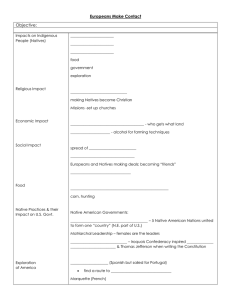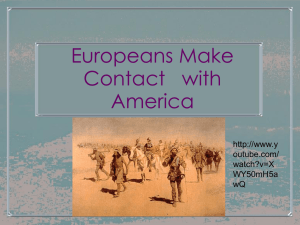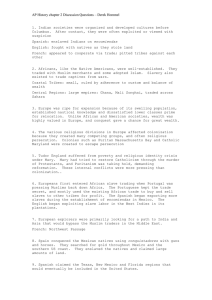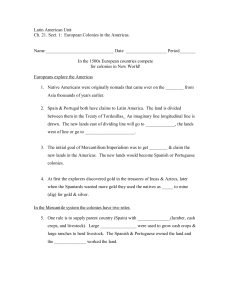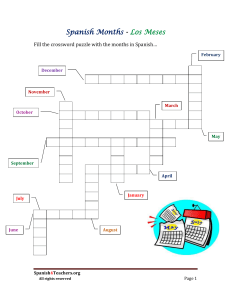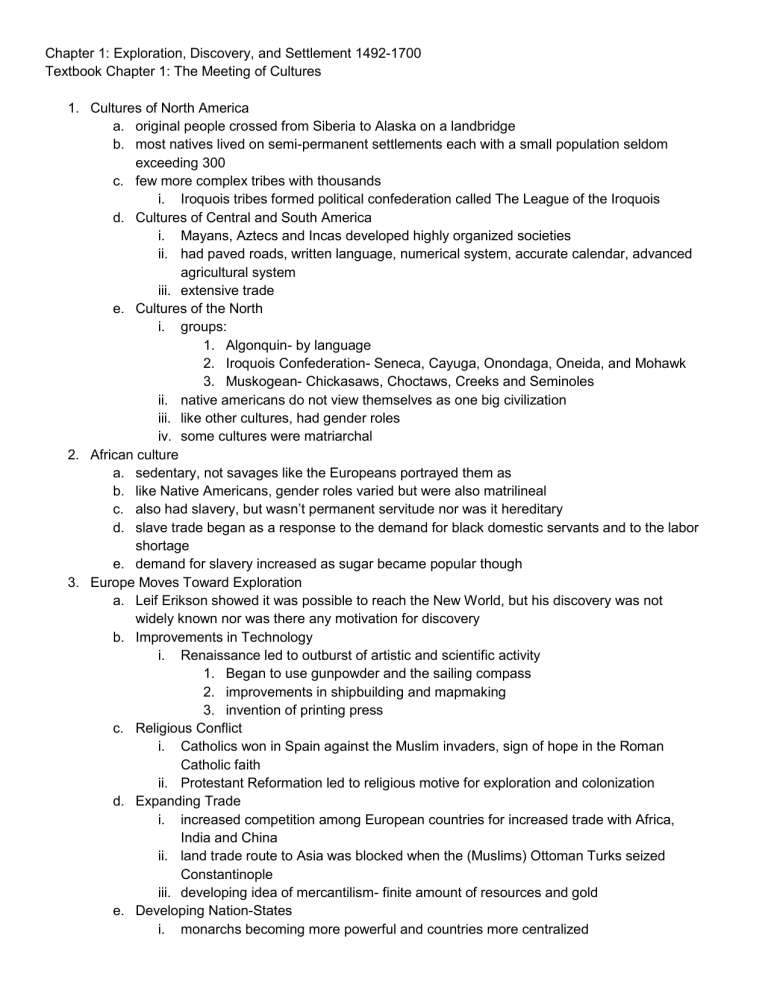
Chapter 1: Exploration, Discovery, and Settlement 1492-1700 Textbook Chapter 1: The Meeting of Cultures 1. Cultures of North America a. original people crossed from Siberia to Alaska on a landbridge b. most natives lived on semi-permanent settlements each with a small population seldom exceeding 300 c. few more complex tribes with thousands i. Iroquois tribes formed political confederation called The League of the Iroquois d. Cultures of Central and South America i. Mayans, Aztecs and Incas developed highly organized societies ii. had paved roads, written language, numerical system, accurate calendar, advanced agricultural system iii. extensive trade e. Cultures of the North i. groups: 1. Algonquin- by language 2. Iroquois Confederation- Seneca, Cayuga, Onondaga, Oneida, and Mohawk 3. Muskogean- Chickasaws, Choctaws, Creeks and Seminoles ii. native americans do not view themselves as one big civilization iii. like other cultures, had gender roles iv. some cultures were matriarchal 2. African culture a. sedentary, not savages like the Europeans portrayed them as b. like Native Americans, gender roles varied but were also matrilineal c. also had slavery, but wasn’t permanent servitude nor was it hereditary d. slave trade began as a response to the demand for black domestic servants and to the labor shortage e. demand for slavery increased as sugar became popular though 3. Europe Moves Toward Exploration a. Leif Erikson showed it was possible to reach the New World, but his discovery was not widely known nor was there any motivation for discovery b. Improvements in Technology i. Renaissance led to outburst of artistic and scientific activity 1. Began to use gunpowder and the sailing compass 2. improvements in shipbuilding and mapmaking 3. invention of printing press c. Religious Conflict i. Catholics won in Spain against the Muslim invaders, sign of hope in the Roman Catholic faith ii. Protestant Reformation led to religious motive for exploration and colonization d. Expanding Trade i. increased competition among European countries for increased trade with Africa, India and China ii. land trade route to Asia was blocked when the (Muslims) Ottoman Turks seized Constantinople iii. developing idea of mercantilism- finite amount of resources and gold e. Developing Nation-States i. monarchs becoming more powerful and countries more centralized ii. needed both the Church to justify their rule and trade to bring in money 4. Early Explorations a. Columbus i. Isabella and Ferdinand (Spain) gave Columbus financial support ii. Discovered lands on the other side of the ocean, but they were not Asia iii. criticized as a failure because he did not find another route to Asia, wasn’t even named after him, his arrival was the beginning of Native American mistreatment iv. but he started the first permanent interactions between Europeans and Native Americans v. his own personal motivations were a microcosm of the Age of Discovery in general 1. religious- “God made me the messenger of the new heaven and the new earth and he showed me the spot where to find it.” b. Exchanges i. DNA ;) ;) ii. Natives --> Europeans: 1. beans, corn, sweet and white potatoes, tomatoes, and tobacco 2. syphilis! :D GOOD JOB iii. Europeans --> Natives: 1. sugar cane, bluegrasses, bananas, cattle, pigs and horses 2. wheel, iron implements, guns 3. influenza, measles, chicken pox, mumps, typhus and SMALLPOX, which decimated the Native American population (partially on purpose) c. Dividing the New World i. Line of Demarcation drawn by Spain and Portugal on South America, giving Spain the west and Portugal the east (Brazil) ii. Treaty of Tordesillas moved the line a few degrees to the west 5. Spanish a. Spanish Exploration and Conquest i. conquistadores brought back gold and silver, making Spain the richest and most powerful nation in the world ii. Cortés destroyed the Aztecs, more with smallpox than anything else “God saw fit to send the Indians smallpox.” iii. after taking the natives’ bullion, the Spanish enslaved them for agriculture iv. encomienda system- king gave permission to enslave natives and gave land grants v. asiento system- brought slaves from West Africa, forced Spanish to pay tax to king on slaves vi. Catholicism only religion of the new territories, changed the primary motivation from GOLD to GOD vii. Pueblo Revolt of 1680 forced Spanish to change their policies from harshly CATHOLICCATHOLICCATHOLIC to ASSIMILATE but you can practice your own culture too viii. paradoxically, they justified their elimination of the natives b/c they were savages...except they only eliminated them b/c they weren’t savages, because they were a threat ix. intermarriages common b. Spanish Settlements in North America i. developed slowly because of limited mineral resources and strong opposition from natives ii. Southwest 1. colonies north of Mexico were weak, but the strongest of those was New Mexico a. Santa Fe established as capital of New Mexico, went too far with conversion efforts so the Pueblo people drove the Spanish away 2. California settled to prevent British and French presence in the region a. San Diego and San Francisco b. destroyed the native population with disease c. converted Indians to Catholicism (Father Junipero Serra) 3. Texas was also defended from European competition with San Antonio iii. Southeast 1. conflict between England’s Georgia and Spain’s Florida 2. lots of fighting diminished the Spanish presence there, forced them to intermarry with blacks and natives 3. England wins Florida in the French and Indian War 6. Non-Spanish a. English Claims i. John Cabot’s exploration of Newfoundland in 1497 was not followed up because of the religious issues in England (Civil War) ii. English inspired by Thomas Mores’ Utopia and spurred to America by the Agricultural Revolution iii. defeated Spanish Armada, so they had gained a reputation as a major naval power iv. Richard Hakluyt supported colonization: 1. new markets for English goods 2. alleviate poverty and unemployment 3. more natural resources v. Sir Frances Drake plundered Spanish ships of their gold and silver and attacked Spanish settlements vi. Sir Walter Raleigh’s Roanoke Island settlement failed mysteriously b. French Claims i. Jacques Cartier explored the St. Lawrence River extensively ii. Like English, were slow to develop colonies in New World because French Catholics had no inclination to leave and French Protestants would have been excluded from the colonies iii. Samuel de Champlain- “Father of New France”- established first permanent French settlement in America iv. Robert de La Salle explored the Mississippi basin, named Louisiana after the king c. Dutch Claims i. Henry Hudson sought northwest passage, sailing up the Hudson River and established Dutch claims to New Amsterdam ii. The Dutch West India Company, a private joint-stock company, gained control of region for economic profit 7. Differences between Spanish and English colonies a. Spanish colonies had no opportunity for political independence unlike the English colonies b. Because Spanish colonies were more successful in extracting surface wealth, they invested less time and money in agriculture and commerce c. they forced all colonies to go through one Spanish port and a few colonial ports only, stifling the economic development of the New World d. Spanish ruled but did not populate; never created a self-contained European society within the New World like the English 8. European Treatment of Native Americans a. all Europeans viewed native as inferiors who could be exploited for economic, political, and religious gain b. two long term effects were: i. destruction by disease and war of natives ii. establishment of a permanent legacy of subjugation c. Spanish Policy i. conquistadores’ methods of war, efforts at enslavement and European diseases killed the natives ii. few families settled the new empire, so intermarriages between natives, Africans and Spaniards were common iii. rigid class system developed with pure-blooded Spaniards on top iv. sought to convert natives to Catholicism, recruit them and cultivate them as trading partners, but did not want to displace them as the English did d. English Policy i. Initially Native Americans showed Europeans new crops and how to hunt in forests ii. they were also a market for manufactured goods iii. However, English viewed natives as savage, after their experience with colonizing the Irish (there was a vicious war) iv. separate society-- not much intermarriage v. Natives were threatened by territorial expansion necessary by English to support their population e. French Policy i. French aided the Huron people so they could control the fur trade ii. social assimilation necessary for successful economic fur partnerships iii. few colonists, farms or towns f. Dutch Policy i. active fur trade, like the French ii. encouraged settlement iii. weak leadership though g. Middle Grounds- places where Europeans and Indians lived together in regions in which neither side was able to establish clear dominance i. Indians wanted Europeans to help them mediate their own internal disputes and offer them gifts ii. French were good at this, British weren’t good at gift-giving iii. stability decreased as new settlers stopped caring about the intricate rituals
